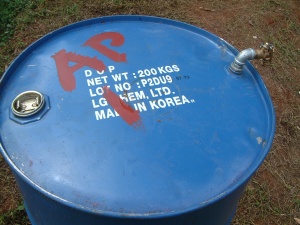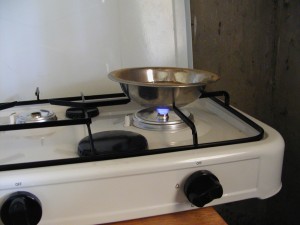Wednesday, September 21, 2011
|  2 comments
2 comments
 2 comments
2 comments
Wednesday, September 21, 2011
|  No comments
No comments
 No comments
No comments
 |
| INLET TANK FOR MIXING WATER AND MANURE (GOBAR) |
 |
| Concrete Foundation for Digester. Center Guide Pipe and Horizontal Cord. |
 |
| BIOGAS LANTERN AMD BIOGAS DOUBLE BURNER STOVE |
 |
| PLANT CONSTRUCTION |
 |
| Earth Base of Excavation is Compacted BIOGAS PLAN |
 |
| BIOGAS PLANT |
 |
| COMPOST PITS WITH BRICK WALLS FOR STABILITY |
 |
| INLET TANK DURING MASONRY CONSTRUCTION |
 |
| INLET TANK |
 |
| SLABS IN PLACE ON OUTLET CHAMBER |
 |
| MANHOLE INSPECTION OF COMPLETE BIOGAS CHAMBER |
 |
| OUTLET CHAMBER , FOUNDATION OF BRICK WITH MANHOLE ADJACENT TO DIGESTER |
 |
| COMPLETE FIXED DOME WITH TURRET |
 |
| MOULD WITH SAND LAYER BEFORE PLACING CAST |
 |
| ARCH GUIDE, LOOP AT RIGHT END FOR PIVOT ON VERTICAL CENTRAL PIPE |
 |
| First Two Courses of Bricks Placed on Top of Foundation. |
 |
| First Two Courses of Bricks Placed on Top of Foundation. |
 |
| Cobbles and Gravel Placed on Compacted Earth Floor. |
 |
| Excavation for Digester. Mechanical or Manual Excavation is Practical. |
 |
| Excavation for Digester. Mechanical or Manual Excavation is Practical. |
 |
| Scale Model of 4 Cubic-Meter Biogas Plant for Training (Camp Nathan Smith, Kandahar, Afghanistan) |
Tuesday, September 20, 2011
|  No comments
No comments
 No comments
No comments
Biogas Plant Construction Manual Fixed-dome Digester: 4 to 20 Cubic Meters
 |
| Afghan-Biogas-Construction |
Forward
In July 2010 United States Forces Afghanistan (USFOR-A) were requested by General David H.Petraeus, Commander International Security and Assistance Force (COMISAF) to investigate the feasibility of biogas technology in Afghanistan. The leading purpose for the rural application of biogas is two-fold: alternative to burning manure and other organic material in the home, and returning nutrientrich fertilizer to the land. Research show these attributes benefit human health and the environment.USFOR-A Joint Engineer Directorate worked closely with United States Agency for International Development (USAID), Islamic Republic of Afghanistan Ministry of Energy and Water – Renewable Energy Department (Director Amir Mohammad Alamzai), Ministry of Rural Rehabilitation and Development, and Ministry of Agriculture, Irrigation and Livestock to investigate existing biogas technology in Afghanistan, identify competent contractors designing and constructing biogas digesters, and identify facilities and institutions with the potential to incorporate biogas technology. Director Alamzai provided USFOR-A contacts at the non-profit organization Agency for Rehabilitation & Energy Conservation in Afghanistan (AREA). AREA had demonstrated experience and knowledge in the design, construction and operation of biogas plants in several provinces of Afghanistan, specifically the fix-dome biogas digester made popular in Asia. USFOR-A contracted AREA to design, construct and operate an 8-cubic meter biogas plant at the Renewable Energy Department, Kabul in the winter and spring of 2010-2011. The biogas plant was completed in six weeks and fed dairy cow manure and water.The manual is based on both the Gobar biogas plant and the performance by AREA during the construction of the biogas plant in Kabul. We sincerely appreciate the support and direction from General Petraeus, Major General Timothy McHale (USFOR-A Deputy Commander for Support), Brigadier General Buckler (Director JENG), Brigadier General Mark Yenter (Director JENG), Brigadier General Mark Martins (Rule of Law Field Force), Colonel Louis Dell‟Orco, Lieutenant Colonels Dallas Olson, Butch Welch and Robert Tucker, PhD (JENG), Mr. Abdul Rasool Wardak and the folks with US Agency for International Development. We also appreciate the skill and work of Staff Sergeant Jeffrey Hart for turning rough sketches into professional Engineer designs and the financial process support of Captain Moses Wearing to ensure funding of this project through the Commander‟s Emergency Rsponse Program. We learned much about the practical design and construction of the biogas plant from Engineer Khail Shah and Engineer Arif Ulla Azimi of AREA and have shared these lessons in this manual. We especially thank Director Alamzai for his support and leadership to guide and direct the project at his facility in Kabul and of course thank the citizens of the United States of America for granting us the resources to accomplish this and many other projects to improve the security and legitimacy of the Government of the Islamic Republic of Afghanistan.
Download:
2011-04-27 Afghan Biogas Construction Manual FINAL
www.scribd.com/.../2011-04-27-Afghan-Biogas-Construction-Manual-
The manual is based on both the Gobar biogas plant and the performance ..... This manual includes design and construction material quantities for the Gobar biogas plant models of 4, 6, 8, 10, 15 and 20 cubic meters capacity. Design and size of a plant other than mentioned above is feasible and a skilled ...Biogas Plant Construction Manual
https://ronna-afghan.harmonieweb.org/.../2011-04-27_Afghan_Biogas_
File Format: PDF/Adobe Acrobat - Quick View27 Apr 2011 – operate an 8-cubic meter biogas plant at the Renewable Energy Department, ..... This manual includes design and construction material quantities for the Gobar biogas plant models of 4, 6, 8, 10, 15 and 20 cubic meters capacity. ... mentioned above is feasible and a skilled engineer should be consulted for ...
Thursday, September 15, 2011
|  No comments
No comments
 No comments
No comments
State and Federal Policy for Biogas by American Biogas Council
State and Federal Policy for Biogas from American Biogas Council on Vimeo.
The American Biogas Council webinar explored federal- and state-level policies that affect the development of biogas-producing anaerobic digestion facilities.
State and Federal Policy for Biogas from American Biogas Council on Vimeo.
The American Biogas Council webinar explored federal- and state-level policies that affect the development of biogas-producing anaerobic digestion facilities.
Thursday, September 15, 2011
|  2 comments
2 comments
 2 comments
2 comments
Building an Anaerobic Digester
KCIS has been workin gon anaerobic digester designs for a while. Apart from efficiency and safety, we have to look at cost.
We want the be able to offer an anaerobic digester to rural communitites so that peple do not have to cut down trees for firewood or charcoal, but we are also looking for a design that will furnish commercial premises (hotels, etc.) with a reliable fuel supply for cooking and water heating.
Organic waste is introduced through the screwed filler cap where it is broken down by bacteria in the slurry. Heat is an important factor, the process working best at around 40° C. Locating the Digester tank in a sunny area will supply the necessary heat. As gas is produced, it is forced through the Scrubber, which helps to remove any sulphur compounds in the gas. The methane then passes through the cleaner tank, which removes any carbon dioxide from the gas. The gas is under pressure frpm the header tank. The header tank ensures that the Cleaner Tank has a good level of water, and also puts the coollected gas under pressure. The higher the header tank, the more pressure is produced. From time to time, (about 6 months) the sludge is removed from the Digester tank. This sludge, and any liquid recuperated, makes a very good, sterile fertiliser. Any pathogens that may have been introduced are killed off at 40°C, the working temperature of the digester.
We have built the simplest of anaerobic digesters to prove the theory. We did not follow any of my designs due to cost constraints, but have built it so that it can be improved later.
We intend to add a storage drum with a water-filled header tank to provide a near constant pressure.
Source: Kenyan Community Support Initiative
KCIS has been workin gon anaerobic digester designs for a while. Apart from efficiency and safety, we have to look at cost.
We want the be able to offer an anaerobic digester to rural communitites so that peple do not have to cut down trees for firewood or charcoal, but we are also looking for a design that will furnish commercial premises (hotels, etc.) with a reliable fuel supply for cooking and water heating.
Biogas - Anaerobic Digester Mk. 2
Organic waste is introduced through the screwed filler cap where it is broken down by bacteria in the slurry. Heat is an important factor, the process working best at around 40° C. Locating the Digester tank in a sunny area will supply the necessary heat. As gas is produced, it is forced through the Scrubber, which helps to remove any sulphur compounds in the gas. The methane then passes through the cleaner tank, which removes any carbon dioxide from the gas. The gas is under pressure frpm the header tank. The header tank ensures that the Cleaner Tank has a good level of water, and also puts the coollected gas under pressure. The higher the header tank, the more pressure is produced. From time to time, (about 6 months) the sludge is removed from the Digester tank. This sludge, and any liquid recuperated, makes a very good, sterile fertiliser. Any pathogens that may have been introduced are killed off at 40°C, the working temperature of the digester.
We have built the simplest of anaerobic digesters to prove the theory. We did not follow any of my designs due to cost constraints, but have built it so that it can be improved later.
Source: Kenyan Community Support Initiative
Thursday, September 15, 2011
|  No comments
No comments
 No comments
No comments
Wednesday, September 14, 2011
|  No comments
No comments
 No comments
No comments
Biogas From Banana Plants
Wednesday, September 14, 2011
|  No comments
No comments
 No comments
No comments
Letters To Editor -> News Details Biogas in Pakistan
With the energy crisis in Pakistan getting worse day by day, biogas plants in rural areas can play a major role in decreasing the burden on the national energy grids. Even in the developed countries like UK, biogas plants are being built and encouraged with the help of government funds and many other incentives. In our neighbouring country India, there are almost two millions biogas plants.
Pakistan’s 70 percent population lives in the rural areas. Most farmers have two or more cows/buffalos. The dung from these cattle mixed with an equal proportion of water can be used to produce biogas in a biogas plant. This biogas can then be used for cooking purposes or to generate electricity through a gas fired engine whereas the residue from this plant can be used as a fertiliser. Typically, 50 kg cow dung is required to produce 100 cubic feet of biogas that is sufficient to fulfil the daily requirements of a family of five or six members.
About 4,137 biogas plants were installed in Pakistan with the help of the government in the period 1974 to 1987. The government fully funded the first 100 installations and later on withdrew the financial support. Since then, the growth rate of this technology dropped drastically and only 6,000 biogas plants were installed till the end of 2006. Pakistan Centre for Renewable Energy Technologies (PCRET) has already installed and supported 4,000 biogas plants with only 50 percent financial contribution from beneficiaries.
There are significant social, economic and environmental benefits of biogas technology. The government of Pakistan through PCRET and Alternative Energy Development Board (AEDB) should take the initiative and announce more funds and support for this proven technology to be a part of our rural society. In parallel, the media should raise the level of awareness among the rural community by highlighting the benefits of this technology. NGOs and foreign investors should be encouraged to invest in this sector too.
KHURAM PERVEZ
London, UK
With the energy crisis in Pakistan getting worse day by day, biogas plants in rural areas can play a major role in decreasing the burden on the national energy grids. Even in the developed countries like UK, biogas plants are being built and encouraged with the help of government funds and many other incentives. In our neighbouring country India, there are almost two millions biogas plants.
Pakistan’s 70 percent population lives in the rural areas. Most farmers have two or more cows/buffalos. The dung from these cattle mixed with an equal proportion of water can be used to produce biogas in a biogas plant. This biogas can then be used for cooking purposes or to generate electricity through a gas fired engine whereas the residue from this plant can be used as a fertiliser. Typically, 50 kg cow dung is required to produce 100 cubic feet of biogas that is sufficient to fulfil the daily requirements of a family of five or six members.
About 4,137 biogas plants were installed in Pakistan with the help of the government in the period 1974 to 1987. The government fully funded the first 100 installations and later on withdrew the financial support. Since then, the growth rate of this technology dropped drastically and only 6,000 biogas plants were installed till the end of 2006. Pakistan Centre for Renewable Energy Technologies (PCRET) has already installed and supported 4,000 biogas plants with only 50 percent financial contribution from beneficiaries.
There are significant social, economic and environmental benefits of biogas technology. The government of Pakistan through PCRET and Alternative Energy Development Board (AEDB) should take the initiative and announce more funds and support for this proven technology to be a part of our rural society. In parallel, the media should raise the level of awareness among the rural community by highlighting the benefits of this technology. NGOs and foreign investors should be encouraged to invest in this sector too.
KHURAM PERVEZ
London, UK
Saturday, September 03, 2011
|  No comments
No comments
 No comments
No comments
Biogas Upgrading Technology - Cleaning Raw Biogas Into Usable Natural Gas
Technology News
The solution is the implementation of a biogas upgrading or purification system. Biogas upgrading is a series of processes where the gas is first cleaned from contaminants and then dried, so that what is left at the end of the process is 98%+ methane fuel gas. Manufacturers that yield biogas purification systems each have their own different processes and technology that they employ to yield the sales potential gas. A few of them are detailed below.Water Washing
This is the most coarse recipe of purifying biogas. Here raw biogas from the digester is compressed and fed into the scrubber vessel where passing water streams adsorb the gas contaminants leaving near pure methane. The gas is then dried by dessicant in the drier columns and exit the theory as 98%+ pure natural gas.
Pressure Swing Adsorption
Otherwise known as Psa, this purification recipe separates the Co2, Nitrogen, Oxygen and Water from the raw biogas stream by adsorbing gases at high pressure and desorbing them at low pressure as waste. The Psa theory ordinarily consists of 4 different adsorption columns working in sequence; Adsorption, depressurizing, desorption and repressurizing.
The raw biogas is compressed and fed into the bottom of the adsorption column where it is purified. During this time the remaining columns regenerate, such that there is all the time 1 absorber column actively cleaning gas. Psa does not scrub hydrogen sulphide so this most be removed before it enters the compressor.
Polyglycol
Using polyglycol (Tradename Selexol)to purify biogas is similar to the water washing recipe with regeneration. Selexol can adsorb hydrogen sulphide, carbon dioxide and water. However the energy required to regenerate the solution after adsorbing H2S is high, so hydrogen sulphide is removed before the process.
Chemical Reaction
Raw biogas can be upgraded by discrete chemical reactions that remove the C02 and other contaminants from the gas stream. The chemicals such as Alkanolamines react at atmospheric pressure in an adsorption column with the Co2 and are regenerated afterwards with steam. The hydrogen sulphide must first be removed to avoid toxifying the chemicals.
Advantages and Disadvantages
Each plant type fulfills its purpose of supplying high potential natural gas for grid injection. However depending on the site location, discrete environmental and economic factors might make choosing a definite type of theory a more sensible choice. For areas where water is an expensive reserved supply a more thorough option would be a Psa or Selexol theory which regenerate the adsorbent, However this has to be offset against the heat input required in regeneration.
Another foremost factor to think is the methane loss linked with each design. The methane loss is measured using gas analyzers and flowmeters at the suction and extraction sides of the plant. Most plants are guaranteed by manufacturers to perform a maximum 2% methane loss. Some up-to-date studies However have measured between 8-10% methane loss at Psa and Selexol plant sites, perhaps due to leaks and poor maintenance. Chemical systems have even lower guaranteed losses since the chemicals selectively react with the Co2 in the gas stream instead of adsorbing.
Energy Demands
For a biogas upgrading plant the auxiliary power required to drive the compressors, pumps etc is in any place between 3-6% of the total energy production in the form of natural gas. The cost linked with upgrading biogas also decreases with larger plant size, a smallish plant of 100 metres cubed per hour will upgrade gas at more than twice the cost of a plant outputting 200 - 300 metres cubed per hour.
Conclusions
A Digestor is only the beginning of the process to change biomass into beneficial high potential natural gas. A biogas purification theory takes the raw biogas at nearby 60% methane from the digester and straight through a extra process outputs 98% methane for ether use as fuel gas or supplied to the grid. The four main upgrading processes are water washing, pressure swing adsorption, polyglycol adsorption and chemical treatment. Water washing and Psa are the most predominantly used systems in the world today. Typical energy requirements for a biogas purification theory are between 3-6% of the total methane output, with smaller plants cost more to run than larger ones. As digester systems become more coarse nearby the world and citizen begin to catch on to biogas as a renewable source of energy, no doubt we will see more of these systems become ready and more innovative designs.
Source: http://2011technology-news.blogspot.com/2011/09/biogas-upgrading-technology-cleaning.html

















